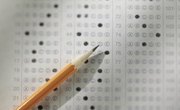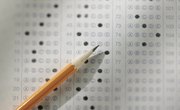A norm-referenced standardized test is one of two commonly used scoring methods for standardized tests. The norm model compares test performance to a norm group of representative students that previously took the test. Students taking a norm standardized test will receive a score that tells them their percentile scored relative to the norm group. To norm standardize a test, you must give the test to a representative, norm group and assign percentiles to the test based on a standard bell curve.
Administer the standardized test to a representative group of students. This group is called the norm group. Make sure your norm group is representative of other students that will later take the test in terms of age, skill level, disabilities and socio-economic background. It is also required that the norm group be large enough to give you a good sample. The size of the norm group, however, should depend on the number of students that will ultimately take the test. For example, if 100 students will take the standardized test, a norm group might consist of 20 students. On the other hand, a standardized test that hundreds of thousands of students will take may require a norm group of 10,000 students.
Score the test results for the norm group. Assign a numeric score to every student based on the number of questions answered correctly. For example, if the standardized test has 100 questions and a student answered 90 questions correctly, assign the student a score of 90.
Plot all the scores from the norm group on a graph. Assign percentiles to the graph based on a bell curve model. In a traditional bell curve, 10 percent of the test takers should score in the 90th percentile or higher; 20 percent should score between the 80th and 90th percentile; 40 percent should score between the 70th and 80th percentile; 20 percent should score between the 60th and 70th percentile; and 10 percent should score lower than the 60th percentile.
Assign a percentile to every possible numerical score based on the bell chart created in Step 3. For example a score of 77 may equate to the 93rd percentile. This means that a student that takes the standardized test in the future and answers 77 questions correctly will receive a score in the 93rd percentile.
Related Articles
References
Writer Bio
Since 1992 Matt McGew has provided content for on and offline businesses and publications. Previous work has appeared in the "Los Angeles Times," Travelocity and "GQ Magazine." McGew specializes in search engine optimization and has a Master of Arts in journalism from New York University.










